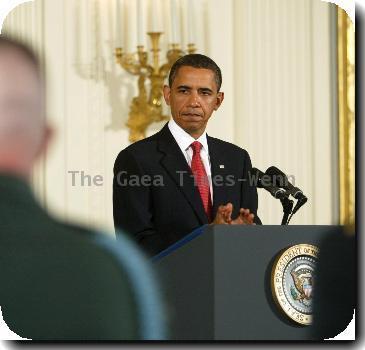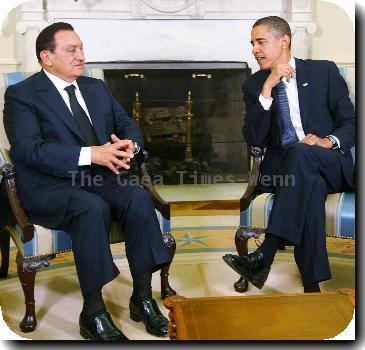US and China pledge to reduce greenhouse gas emissions, but world commitment falls short
By Arthur Max, APFriday, November 27, 2009
US and China to reduce emissions, but not enough
AMSTERDAM — Even after the U.S. and China set targets this week for reducing greenhouse gas emissions, the world’s combined pledges ahead of next month’s climate summit fall far short of what experts say is needed to avert dangerous global warming.
Still, emission promises by the two countries, the world’s biggest polluters, added much-needed momentum as governments began final preparations for the 192-nation conference in Copenhagen, where parameters will be set for a new climate change agreement.
From Beijing to Trinidad, governments huddled Friday to plan their negotiating strategies.
China hosted India and other major developing countries a day after announcing that Beijing would cut “carbon intensity,” a measure of carbon dioxide emissions per unit of production, by 40 to 45 percent by 2020, compared with levels in 2005.
The Chinese target means emissions will continue to grow as its economy expands, but at nearly half the rate they otherwise would have done.
Swedish Prime Minister Fredrik Reinfeldt, whose country presides over the 27-nation European Union, said the Chinese bid was an important signal and a move in the right direction, but there was room for greater reductions.
“We feel that China could do more and we also hope to get further commitments,” he said on the Web site of the EU presidency.
Unofficial calculations by U.N. climate officials said the move would put China on a path to reduce all its greenhouse gas emissions about 13 percent from “business as usual,” the level those emissions would have reached without any action.
The Chinese move was expected to put pressure on India, which has failed to put forward any numbers for curbing emissions growth.
In India, where some 400 million people lack access to electricity, “climate change is not regarded as a national priority,” according to an internal U.N. assessment.
However, India’s environment minister, Jairam Ramesh, indicated that his country was reviewing its position after the Chinese announcement, which he described as “a wake-up call.”
“We have to think hard about our climate strategy now and look for flexibility,” Ramesh told The Hindustan Times.
Press Trust of India reported from Beijing that India also may accept a carbon intensity target, but not as steep as China’s.
In other meetings Friday, Brazilian President Luiz Inacio Lula da Silva told a meeting of Amazon nations in his capital that rich countries must “pay the price” for preservation of the world’s largest rain forest, which is considered vital for soaking carbon from the air.
British Commonwealth nations gathered in Trinidad to debate a declaration representing the common views of 53 widely divergent nations.
Canada’s Prime Minister Stephen Harper, who pulled his Commonwealth country out of the 1997 Kyoto Protocol that would have limited Canada’s emissions, reversed his decision to stay away from Copenhagen after Obama and Chinese Premier Wen Jiabao said they would attend.
Harper’s Conservative government says it plans to cut greenhouse gases by 20 percent by 2020 from 2006 levels, which are slightly tougher than measures announced by the U.S.
The U.S. and China have yet to address the critical issue of how to raise the hundreds of billions of dollars needed annually to rescue poor countries from storms, floods and drought that are expected to become more severe as greenhouse gases worsen.
It wasn’t until recently that the U.S. and China were willing to put any numbers on the table regarding carbon emission reductions.
The stalemate broke Wednesday when the White House said President Barack Obama, who will attend the Copenhagen conference Dec. 9, would pledge to reduce U.S. emissions by 17 percent from 2005 levels by 2020, and that the U.S. would continue that downward path over the following 10 years to reach a 41 percent reduction.
The World Wildlife Fund said the U.S. pledge for 2020 translated to 4 to 5 percent below the commonly accepted benchmark year of 1990.
“It certainly doesn’t bring us closer to that range of emission reduction levels that we need to see,” said Kim Carstensen, WWF’s climate change director.
Scientists say the industrial countries must slash carbon emissions by 25 to 40 percent by 2020 below 1990 to prevent the Earth from adding two degrees Centigrade (3.6F), the maximum considered safe.
In addition, developing countries need to lower their emissions growth by 15 to 30 percent from business as usual, according to the authoritative U.N. Intergovernmental Panel on Climate Change.
Those figures appeared in the panel’s 2007 report, based on studies and computer models conducted at least two years earlier. Current studies suggest global warming is happening faster than the panel predicted.
Carstensen said the Chinese announcement left open the question of how its unilateral actions will fit into an international accord. That could emerge as one of the toughest issues in Copenhagen, he said.
China and India have insisted that any action they undertake on their own without international financing should be free of scrutiny. The industrial countries want a system to ensure that even domestic action is transparent.
“It will be so central for the negotiations that there will need to be an agreement, at least on the headlines,” Carstensen told The Associated Press. Specific rules for accounting and measuring energy efficiency could be worked out next year, he said.
One proposal under discussion is for developing countries to list their plans in an international registry, but they would face no consequences if they fell short.
Despite the shortfall of the pledges, the Danish hosts of next month’s conference were heartened by the Chinese and American positions, and earlier announcements from South Korea, Brazil and Russia advancing their commitments.
The U.S. rejected the Kyoto Protocol and took no federally mandated action to trim carbon emissions during George W. Bush’s presidency.
The U.S. offer to reduce emissions may appear unimpressive, Denmark’s Climate Minister Connie Hedegaard said, “but the U.S. seems to know that the price for coming late is that the pathway for reductions after 2020 will be extra steep.”
“Governments from all over the world are delivering before the climate conference,” Hedegaard said. “All across the globe, things are moving.”
Tags: Amazon, Amsterdam, Asia, Barack Obama, Beijing, China, Climate, Climate Change, Copenhagen, Denmark, East Asia, Environmental Concerns, Europe, Global Environmental Issues, Greater China, Greenhouse Gases, India, International Agreements, North America, South Asia, United Nations Climate Change Conference, United States, Western Europe


